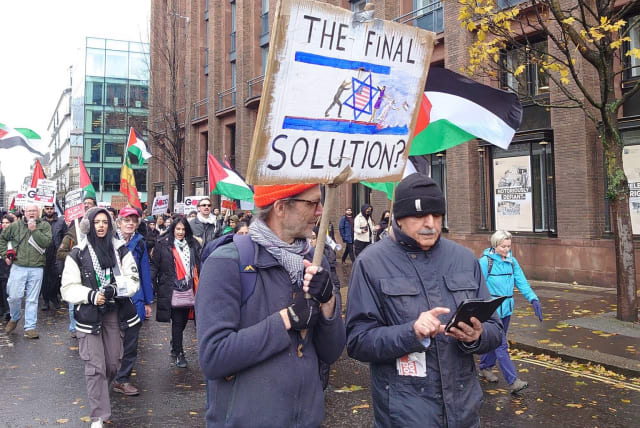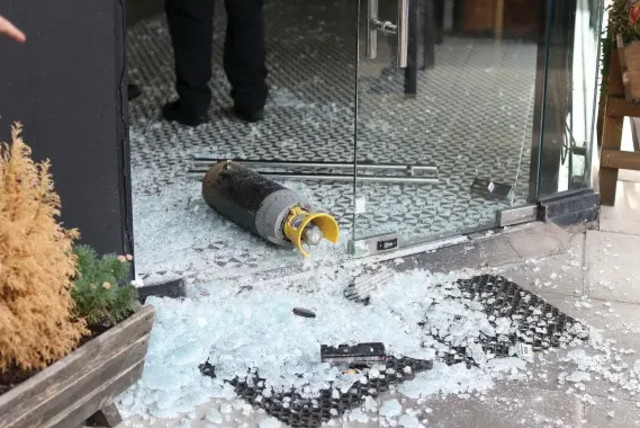How does the current wave of antisemitism fit into past trends? -interview

IHRA and Shoah Foundation Executive Director Dr. Rober Williams told the Jerusalem Post that s "decline in social fabric" is part of the ongoing antisemitism trend.
The wave of antisemitism in the wake of the October 7 massacre is part of a rising global undercurrent of Jew-hatred since 2014, according to Dr. Robert Williams, chairman of UNESCO Antisemitism and Holocaust Research, adviser to the International Holocaust Remembrance Alliance, and executive director of the Shoah Foundation.The current “decline in social fabric” is part of ongoing trends in antisemitism “though an escalation of the negative trends that we’ve seen so far,” he told The Jerusalem Post in an interview last Monday.
“Antisemitism has been a constant since the end of the Holocaust, unfortunately,” Williams said.
Incidents from 2014 onwards
Almost 10 years ago, in the 2014-2015 period, there was a spike in antisemitism in many countries across the world, he said, adding: “There are those that may say the trend may start earlier, but you see in 2014 from the Right and Islamist quarters extreme terrorism attacks.”
There was a trend of shooting attacks in that period, Williams said, including the Overland Park shootings at the Jewish Community Center of Greater Kansas City Village Shalom retirement home, and the Jewish Museum of Belgium. In 2015, there was the deadly terrorist attack at the Bataclan theater in Paris, which had been targeted in the past because it was owned by a Jewish family, he added.
During the 2014-2015 period, Williams said, “you see the rise of populist movements which have antisemitic ideologies attached to them and mask themselves in anti-Israel animus.”
The world has since seen slowly rising antisemitism with spikes during warfare in Gaza, when there is an opportunity and excuse to express antisemitic animosity, he said, adding that radical Islamists and far-right provocateurs had managed to conceal their antisemitism under the guise of anti-Zionism until the current conflict.There was also a spike in antisemitism during the 2019 coronavirus pandemic, “where you see new manifestations and echoes of ‘older themes’” in Jew-hatred, Williams said, including classical accusations of Jews as carriers and sources of disease.
In the period of the Black Death, a bubonic plague pandemic in the 1300s, Jews were cast as scapegoats and suffered massacres at the hands of their European neighbors, he said. During the coronavirus pandemic, Israel was compared to a disease, COVID-48, in online discourse, just as Jews had been compared to pests and vermin in classical antisemitic literature, he added.
During the coronavirus pandemic, Jews saw a rise in street attacks in New York City. Many of these attacks, such as the machete attack in Monsey during Hanukkah in 2019 and the Jersey City shooting in 2019, were not conducted by white or Islamic supremacists but by black supremacists.
In 2021, coinciding with Operation Guardian of the Walls, radical right-wing groups started to appear at the same protests as far-left or Islamic anti-Israel groups, Williams said, adding that this dynamic alliance can be seen continuing to manifest today, especially in online discourse.
During this period, there also was an increase in very “violent rhetoric,” such as the protests in Toronto, Williams said.
In some of the Toronto protests, demonstrators repeatedly urged an intifada, cheered for news of rocket attacks, and called for the destruction of Israel, he said. The slogan “by any means necessary” became popular among some groups during this period.
There was a period of very short mourning for the lives lost on October 7, Williams said, but it did not take long before Jews were blamed for perceived Israeli wrongs against Palestinians. There was a return of some old themes, such as distortion of the Holocaust, presenting Israelis as the new Nazis, and comparing the operation in Gaza to the genocide that Nazis perpetrated, he said.
Brazilian President Luiz Inácio Lula da Silva set off a diplomatic storm in mid-February when he made such a comparison.
“It’s completely unacceptable,” Williams said. “It doesn’t matter where the political leader is coming from; which political spectrum they’re on.”
Such comparisons minimize the understanding of the Holocaust, he said.
Williams, whose Shoah Foundation maintains an archive of Holocaust survivor testimonies, said one cannot compare the Holocaust to other crimes like the Holodomor, also known as the Ukrainian Famine. Such comparisons strip the Holodomor of its context and importance and simplify the crimes rather than seeking to better understand their uniqueness, he said.
Comparisons of Israeli actions to that of the Nazis are “irresponsible,” and it is “necessary to reject and condemn them,” he added.
There has also been a trend of denial of Hamas’s October 7 atrocities, Williams said. The Shoah Foundation partnered with the National Library of Israel on March 4, not just offering their archive of Holocaust testimonies to all of Israel, but also the 400 October 7 accounts that they had collected, he said, adding that the foundation would soon launch a media campaign highlighting the evidence it had collected.
“What has followed in the wake of October 7 shocked and shined a light on what we’ve long suspected,” Williams said regarding the jubilation and Jew-hatred expressed online and offline.
Anti-Israel protesters took to the streets even before Israeli operations in Gaza had begun. In Sydney, demonstrators were heard chanting, “Gas the Jews.” Online, some Palestinian nationalists called for the event to be a new holiday.
There was an affirmation of how dangerous antisemitism could be on the extreme Left, “which we knew about, but it hadn’t manifested to such an extent,” Williams said.
This bald-faced evil also presented an opportunity to address the problem, he said, adding: “Now, people understand that it’s not just the person with the Nazi armband that is an antisemite.”
The hatred exists on both sides of the political spectrum and manifests itself in different and sometimes more subtle ways, Williams said. The age-old hatred needs to be addressed, and “it doesn’t matter if it comes from the Left or Right,” he said.
Jerusalem Post Store
`; document.getElementById("linkPremium").innerHTML = cont; var divWithLink = document.getElementById("premium-link"); if (divWithLink !== null && divWithLink !== 'undefined') { divWithLink.style.border = "solid 1px #cb0f3e"; divWithLink.style.textAlign = "center"; divWithLink.style.marginBottom = "15px"; divWithLink.style.marginTop = "15px"; divWithLink.style.width = "100%"; divWithLink.style.backgroundColor = "#122952"; divWithLink.style.color = "#ffffff"; divWithLink.style.lineHeight = "1.5"; } } (function (v, i) { });

